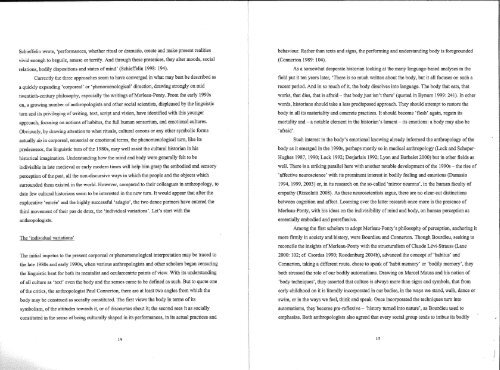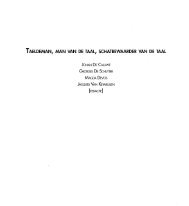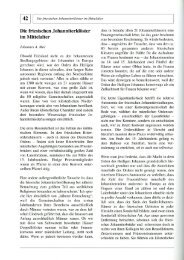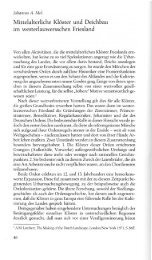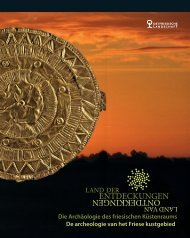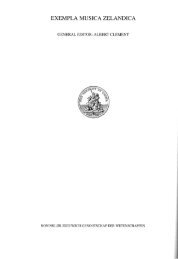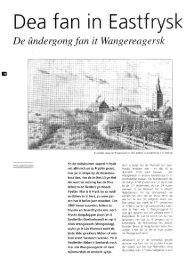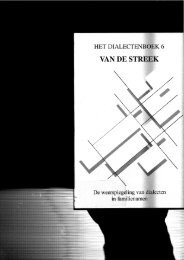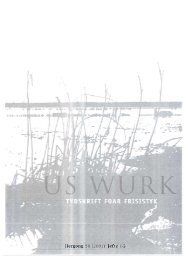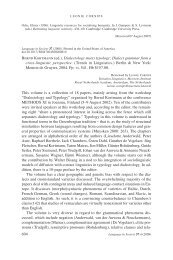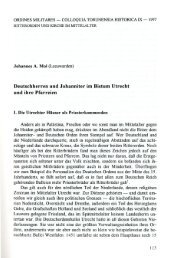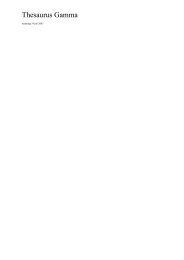Antropologen, historici en de hartslag van het archief
Antropologen, historici en de hartslag van het archief
Antropologen, historici en de hartslag van het archief
You also want an ePaper? Increase the reach of your titles
YUMPU automatically turns print PDFs into web optimized ePapers that Google loves.
Schieffelin wrote, 'performances, w<strong>het</strong>her ritual or dramatic, create and make pres<strong>en</strong>t realities<br />
vivid <strong>en</strong>ough to beguile, amuse or terrify. And through these pres<strong>en</strong>ces, they alter moods, social<br />
relations, bodily dispositions and states of mind' (Schieffelin 1998: 194).<br />
Curr<strong>en</strong>tly the three approaches seem to have converged in what may best be <strong>de</strong>scribed as<br />
a quickly expanding 'corporeal' or 'ph<strong>en</strong>om<strong>en</strong>ological' direction, drawing strongly on mid<br />
tw<strong>en</strong>tieth-c<strong>en</strong>tury philosophy, especially the writings ofMerleau-Ponty. From the early 1990s<br />
on, a growing number of anthropologists and other social sci<strong>en</strong>tists, displeased by the linguistic<br />
turn and its privileging of writing, text, script and vision, have id<strong>en</strong>tified with this younger<br />
approach, focusing on notions of habitus, the full human s<strong>en</strong>sorium, and emotional cultures.<br />
Obviously, by drawing att<strong>en</strong>tion to what rituals, cultural canons or any other symbolic forms<br />
actually do in corporeal, s<strong>en</strong>sorial or emotional terms, the ph<strong>en</strong>om<strong>en</strong>ological tum, like its<br />
pre<strong>de</strong>cessor, the linguistic turn of the 1980s, may well assist the cultural historian in his<br />
historical imagination. Un<strong>de</strong>rstanding how the mind and body were g<strong>en</strong>erally felt to be<br />
indivisible in late medieval or early mo<strong>de</strong>m times will help him grasp the embodied and s<strong>en</strong>sory<br />
perception of the past, all the non-discursive ways in which the people and the objects which<br />
surroun<strong>de</strong>d them existed in the world. However, compared to their colleagues in anthropology, to<br />
date few cultural historians seem to be interested in the new tum. It would appear that after the<br />
explorative '<strong>en</strong>tree' and the highly successful 'adagio', the two dance partners have <strong>en</strong>tered the<br />
third movem<strong>en</strong>t of their pas <strong>de</strong> <strong>de</strong>ux, the 'individual variations'. Let's start with the<br />
anthropologists.<br />
The 'individual variations'<br />
The initial impetus to the pres<strong>en</strong>t corporeal or ph<strong>en</strong>om<strong>en</strong>ological interpretation may be traced to<br />
the late 1980s and early 1990s, wh<strong>en</strong> various anthropologists and other scholars began c<strong>en</strong>suring<br />
the linguistic b<strong>en</strong>t for both its m<strong>en</strong>talist and ocularc<strong>en</strong>tric points of view. With its un<strong>de</strong>rstanding<br />
of all culture as 'text' ev<strong>en</strong> the body and the s<strong>en</strong>ses came to be <strong>de</strong>fined as such. But to quote one<br />
of the critics, the anthropologist Paul Connerton, there are at least two angles from which the<br />
body may be construed as socially constituted. The first views the body in terms of its<br />
symbolism, of the attitu<strong>de</strong>s towards it, or of discourses about it; the second sees it as socially<br />
constituted in the s<strong>en</strong>se of being culturally shaped in its performances, in its actual practices and<br />
14<br />
behaviour. Rather than texts and signs, the performing and un<strong>de</strong>rstanding body is foregroun<strong>de</strong>d<br />
(Connerton 1989: 104).<br />
As a somewhat <strong>de</strong>sperate historian looking at the many language-based analyses in the<br />
field put it t<strong>en</strong> years later, 'There is so much writt<strong>en</strong> about the body, but it all focuses on such a<br />
rec<strong>en</strong>t period. And in so much of it, the body dissolves into language. The body that eats, that<br />
works, that dies, that is afraid- that body just isn't there' (quoted in Bynum 1999: 241). In other<br />
words, historians should take a less predisposed approach. They should attempt to restore the<br />
body in all its materiality and concrete practices. It should become 'flesh' again, regain its<br />
mortality and - a notable elem<strong>en</strong>t in the historian's lam<strong>en</strong>t - its emotions: a body may also be<br />
'afraid' .<br />
Such interest in the body's emotional knowing already informed the anthropology of the<br />
body as it emerged in the 1990s, perhaps mostly so in medical anthropology (Lock and Scheper<br />
Hughes 1987, 1990; Lock 1992; Desjarlais 1992; Lyon and Barbalet 2000) but in other fields as<br />
well. There is a striking parallel here with another notable <strong>de</strong>velopm<strong>en</strong>t of the 1990s - the rise of<br />
'affective neurosci<strong>en</strong>ce' with its promin<strong>en</strong>t interest in bodily feeling and emotions (Damasio<br />
1994,1999,2003) or, in its research on the so-called 'mirror neurons', in the human faculty of<br />
empathy (Rizzolatti 2008). As these neurosci<strong>en</strong>tists argue, there are no clear-cut distinctions<br />
betwe<strong>en</strong> cognition and affect. Looming over the latter research once more is the pres<strong>en</strong>ce of<br />
Merleau-Ponty, with his i<strong>de</strong>as on the indivisibility of mind and body, on human perception as<br />
ess<strong>en</strong>tially embodied and prereflexive.<br />
Among the first scholars to adopt Merleau-Ponty's philosophy of perception, anchoring it<br />
more firmly in society and history, were Bourdieu and Connerton. Though Bourdieu, seeking to<br />
reconcile the insights of Merleau-Ponty with the structuralism of Clau<strong>de</strong> Levi-Strauss (Lane<br />
2000: 102; cf. Csordas 1990; Rood<strong>en</strong>burg 2004b), ad<strong>van</strong>ced the concept of 'habitus' and<br />
Connerton, taking a differ<strong>en</strong>t route, chose to speak of 'habit memory' or 'bodily memory', they<br />
both stressed the role of our bodily automatisms. Drawing on Marcel Mauss and his notion of<br />
'body techniques', they asserted that culture is always more than signs and symbols, that from<br />
early childhood on it is literally incorporated in our bodies, in the ways we stand, walk, dance or<br />
swim, or in the ways we feel, think and speak. Once incorporated the techniques turn into<br />
automatisms, they become pre-reflexive - 'history turned into nature', as Bourdieu used to<br />
emphasize. Both anthropologists also agreed that every social group t<strong>en</strong>ds to imbue its bodily<br />
15


